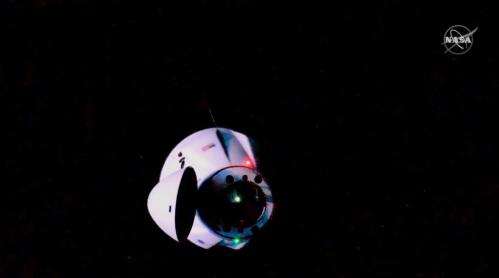
A SpaceX cargo ship that launched on Thursday, June 3, has arrived safely at the International Space Station (ISS) early this morning, Saturday, June 5. This was the 22nd resupply mission by SpaceX, and the uncrewed ship carried a variety of experiments as well as upgrades for the space station and supplies for the crew.
The Space Cargo Dragon craft launched from NASA’s Kennedy Space Center in Florida at about 1:30 p.m. ET on Thursday, carried by a Falcon 9 rocket. The Dragon then traveled over Thursday night and Friday, before arriving at the ISS and docking at 5:09 a.m. ET on Saturday. The spacecraft docked with the Harmony module on the space-facing side of the station, overseen by NASA astronauts Shane Kimbrough and Megan McArthur from onboard the station.
NASA also shared a striking video clip of the Dragon flying into the orbital daytime on its approach to the ISS:
The @SpaceX cargo Dragon flies into orbital daytime as it continues approach to the @Space_Station for docking this morning: pic.twitter.com/AbuLLzrXCq
— NASA (@NASA) June 5, 2021
The Dragon was carrying over 7,300 pounds of supplies, including new solar panels to be added to the ISS as part of a long-term power system upgrade to the station. The Roll-out Solar Arrays (iROSA) are more efficient than the 20-year-old panels currently on the station and should provide a boost to available power.
There are also a number of scientific experiments in the cargo, including experiments with microscopic and incredibly hardy creatures called tardigrades, also known as water bears. Researchers hope to learn more about how these creatures survive in extreme environments. And these aren’t the only quirky creatures hitching a ride into space, as they are also joined by glow in the dark bobtail squid, small sea creatures which are being used in research into the relationship between host animals and microbes.
The station now has a total of five spacecraft docked with it. In addition to the newly arrived Cargo Dragon, coded CRS-22, there is also a Crew-2 Dragon which carried a group of four astronauts to the station in April this year, a Northrop Grumman Cygnus cargo craft named after Katherine Johnson, and two Russian craft: A Soyuz MS-18 crew ship and a Progress 77 resupply ship.
NASA shared a graphic showing the location of all the craft currently at the ISS:
Editors' Recommendations
- Watch SpaceX’s Crew Dragon take one of its shortest journeys on Thursday
- China’s space station was hit by space junk
- Junk from the ISS fell on a house in the U.S., NASA confirms
- SpaceX all set for a record-breaking rocket launch on Friday
- Watch SpaceX blast its megarocket engines in spectacular test